Stability Reinforcement of Slopes Using Vegetation Considering the Existence of Soft Rock
Abstract
:1. Introduction
2. Materials and Methods
2.1. Project Background and Site Description
2.2. Numerical Model and Simulation
2.2.1. Reinforcement of Vegetation on Soil Strength
2.2.2. Numerical Model Development
2.2.3. Simulation Scenarios
3. Results
3.1. Effect of Vegetation on the Slope Stability without Rainfall
3.2. Effect of Vegetation on the Slope Stability with Rainfall
4. Discussion
5. Conclusions
- (1)
- The addition of vegetation indeed increased the safety of slope stability, whether the slope is under a dry condition or a rainfall condition. The effectiveness of young and mature forests is basically more effective to increase the slope stability compared to that of grass and shrubs, although the young and mature forest leads to a surcharge to the slope.
- (2)
- The stability of the slope gradually reduced with the increase of infiltration of water due to rainfall. The increasing proportion due to vegetation reinforcement for various rainfall conditions positively or negatively varied with the rainfall time, indicating that the increase of FS due to vegetation reinforcement is dependent on the current situation of the slope. With the same amount of rainfall for the case without vegetation reinforcement, the FS value calculated with larger rainfall intensity (50 mm/day) is smaller than that calculated with smaller rainfall intensity (10 mm/day). For the case with vegetation reinforcement under the same rainfall volume, FS for the heavier rainfall case is not always larger than that for the smaller rainfall cases, demonstrating that the addition of vegetation has changed the potential slip mode and surface, compared to that without vegetation.
- (3)
- In this case, the critical slip surface is much deeper, which resulted in that the reinforcement effect of the four vegetation are not proportional to their cohesion addition and influencing depth. It does not match the expectation that the deeper the reinforcement depth is, the safer the slope is. In practice, the design of vegetation reinforcement should be analyzed in advance.
- (4)
- Compared to the slopes with shallow potential slip surfaces, the increase of FS due to vegetation reinforcement for this case is very limited. The reason is that the rather deeper critical slip surface was not intercepted by the vegetation root, even for the mature forest, which failed to provide enough shear resistance for the soil around the slip surface. For the specific case, the effectiveness of vegetation reinforcement should be evaluated in advance. If the depth of the potential slip surface is over the maximum depth of the vegetation root, it may be not appropriate to use vegetation as a way of slope reinforcement.
- (5)
- Using average or minimum soil strength parameters may overestimate or underestimate the safety of the slope due to the variations of soil parameters in spatial. It is necessary and significant that using random field and reliability theory for the evaluation of slope stability. The spatial variability of the additional cohesion due to vegetation is also meaningful to reasonably evaluate the safety of slope stability.
Author Contributions
Funding
Institutional Review Board Statement
Informed Consent Statement
Data Availability Statement
Acknowledgments
Conflicts of Interest
References
- Jiang, H.; Zhou, X.; Xiao, Z. Stability of extended Earth berm for high landfill. Appl. Sci. 2020, 10, 6281. [Google Scholar] [CrossRef]
- Li, Y.; Qian, C.; Fu, Z.; Li, Z. On two approaches to slope stability reliability assessments using the random finite element method. Appl. Sci. 2019, 9, 4421. [Google Scholar] [CrossRef] [Green Version]
- Feng, S.J.; Chen, Z.W.; Chen, H.X.; Zheng, Q.T.; Liu, R. Slope stability of landfills considering leachate recirculation using vertical wells. Eng. Geol. 2018, 241, 76–85. [Google Scholar] [CrossRef]
- Bida, S.V.; Kuts, O.V. The evaluation of slopes stability of Poltava river valleys loess plateau. J. Geol. Geogr. Geoecol. 2016, 24, 13–19. [Google Scholar]
- Sengani, F.; Mulenga, F. Influence of rainfall intensity on the stability of unsaturated soil slope: Case study of R523 road in Thulamela Municipality, Limpopo Province, South Africa. Appl. Sci. 2020, 10, 8824. [Google Scholar] [CrossRef]
- Liu, L.; Zhang, S.; Cheng, Y.-M.; Liang, L. Advanced reliability analysis of slopes in spatially variable soils using multivariate adaptive regression splines. Geosci. Front. 2019, 10, 671–682. [Google Scholar] [CrossRef]
- Wei, Z.L.; Wang, D.F.; Xu, H.D.; Sun, H.Y. Clarifying the effectiveness of drainage tunnels in landslide controls based on high-frequency in-site monitoring. Bull. Eng. Geol. Environ. 2020, 79, 3289–3305. [Google Scholar] [CrossRef]
- Troncone, A.; Pugliese, L.; Lamanna, G.; Conte, E. Prediction of rainfall-induced landslide movements in the presence of stabilizing piles. Eng. Geol. 2021, 288, 106143. [Google Scholar] [CrossRef]
- Collison, A.J.C.; Anderson, M.G. Using a combined slope hydrology stability model to identify suitable conditions for landslide prevention by vegetation in the humid tropics. Earth Surf. Process. Landf. 1996, 21, 737–747. [Google Scholar] [CrossRef]
- Cherubini, C.; Giasi, C. The influence of vegetation on slope stability. Eng. Geol. Environ. 1997, 1–3, 67–71. [Google Scholar]
- Wang, Z.H.; Mu, B.; Yang, J.S. The effects of plant species diversity on stability, hydrological processes, aesthetic value, vegetation maintenance, of slope eco-engineering. In Proceedings of the World Engineers’ Convention 2004: Vol D, Environment Protection and Disaster Mitigation 2004, Shanghai, China, 2–6 November 2004; pp. 613–619. [Google Scholar]
- Schwarz, M.; Preti, F.; Giadrossich, F.; Lehmann, P.; Or, D. Quantifying the role of vegetation in slope stability: A case study in Tuscany (Italy). Ecol. Eng. 2010, 36, 285–291. [Google Scholar] [CrossRef]
- Ghestem, M.; Sidle, R.C.; Stokes, A. The influence of plant root systems on subsurface flow: Implications for slope stability. Bioscience 2011, 61, 869–879. [Google Scholar] [CrossRef]
- Prasad, A.; Kazemian, S.; Kalantari, B.; Huat, B.B.K.; Mafian, S. Stability of tropical residual soil slope reinforced by live pole: Experimental and numerical investigations. Arab. J. Sci. Eng. 2012, 37, 601–618. [Google Scholar] [CrossRef]
- Kim, D.; Im, S.; Lee, C.; Woo, C. Modeling the contribution of trees to shallow landslide development in a steep, forested watershed. Ecol. Eng. 2013, 61, 658–668. [Google Scholar] [CrossRef]
- Xu, W.; Wang, X.; Zhang, Y.; Liu, Y. A comparison among root soil-conservation effects for nine herbs at the cold region highway in north-eastern China. Eurasian Soil Sci. 2014, 47, 1274–1282. [Google Scholar] [CrossRef]
- Fan, C.C.; Lai, Y.F. Influence of the spatial layout of vegetation on the stability of slopes. Plant Soil 2014, 377, 83–95. [Google Scholar] [CrossRef]
- Keles, S. An assessment of hydrological functions of forest ecosystems to support sustainable forest management. J. Sustain. Forest. 2019, 38, 305–326. [Google Scholar] [CrossRef]
- Wang, S.Y.; Zhao, M.M.; Meng, X.M.; Chen, G.; Zeng, R.Q.; Yang, Q.; Liu, Y.; Wang, B. Evaluation of the effects of forest on slope stability and its implications for forest management: A case study of Bailong River Basin, China. Sustainability 2020, 12, 6655. [Google Scholar] [CrossRef]
- Park, J.; Kim, I.; Kang, J.K. Root reinforcement effect on cover slopes of solid waste landfill in soil bioengineering. Sustainability 2021, 13, 3991. [Google Scholar] [CrossRef]
- Gadi, V.; Singh, S.; Singhariya, M.; Garg, A.; Sreedeep, S.; Ravi, K. Modeling soil-plant-water interaction: Effects of canopy and root parameters on soil suction and stability of green infrastructure. Eng. Comput. 2018, 35, 1543–1566. [Google Scholar] [CrossRef]
- Zhang, K.; Wang, S.; Bao, H.J.; Zhao, X.M. Characteristics and influencing factors of rainfall-induced landslide and debris flow hazards in Shaanxi Province, China. Nat. Hazards Earth Syst. Sci. 2019, 19, 93–105. [Google Scholar] [CrossRef] [Green Version]
- Nguyen, T.S.; Likitlersuang, S.; Jotisankasa, A. Influence of the spatial variability of the root cohesion on a slope-scale stability model: A case study of residual soil slope in Thailand. Bull. Eng. Geol. Environ. 2019, 78, 3337–3351. [Google Scholar] [CrossRef]
- Mei, L.; Yu, X.; Jiang, P.M. Study on the influence of typical plant roots on the stability of slope in the hilly areas of the lower Yangtze River. IOP Conf. 2020, 510, 042005. [Google Scholar]
- Esmaiili, M.; Abdi, E.; Nieber, J.L.; Jafary, M.; Majnounian, B. How roots of Picea abies and Fraxinus excelsior plantations contribute to soil strength and slope stability: Evidence from a study case in the Hyrcanian Forest, Iran. Soil Res. 2021, 59, 287–298. [Google Scholar] [CrossRef]
- Emadi-Tafti, M.; Ataie-Ashtiani, B.; Hosseini, S.M. Integrated impacts of vegetation and soil type on slope stability: A case study of Kheyrud Forest, Iran. Ecol. Model. 2021, 446, 109498. [Google Scholar] [CrossRef]
- Liu, Q.; Su, L.J.; Xia, Z.Y.; Liu, D.X.; Xu, W.N.; Xiao, H. Effects of soil properties and illumination intensities on matric suction of vegetated soil. Sustainability 2019, 11, 6475. [Google Scholar] [CrossRef] [Green Version]
- Capobianco, V.; Robinson, K.; Kalsnes, B.; Ekeheien, C.; Hoydal, O. Hydro-mechanical effects of several riparian vegetation combinations on the streambank stability—A benchmark case in Southeastern Norway. Sustainability 2021, 13, 4046. [Google Scholar] [CrossRef]
- Genet, M.; Stokes, A.; Fourcaud, T.; Norris, J.E. The influence of plant diversity on slope stability in a moist evergreen deciduous forest. Ecol. Eng. 2010, 36, 265–275. [Google Scholar] [CrossRef]
- Ghestem, M.; Veylon, G.; Bernard, A.; Vanel, Q.; Stokes, A. Influence of plant root system morphology and architectural traits on soil shear resistance. Plant Soil 2014, 377, 43–61. [Google Scholar] [CrossRef]
- Mao, Z.; Jourdan, C.; Bonis, M.L.; Pailler, F.; Rey, H.; Saint-Andre, L.; Stokes, A. Modelling root demography in heterogeneous mountain forests and applications for slope stability analysis. Plant Soil 2013, 363, 357–382. [Google Scholar] [CrossRef]
- Mao, Z.; Bourrier, F.; Stokes, A.; Fourcaud, T. Three-dimensional modelling of slope stability in heterogeneous montane forest ecosystems. Ecol. Model. 2014, 273, 11–22. [Google Scholar] [CrossRef]
- Ranjan, V.; Sen, P.; Kumar, D.; Saraswat, A. Enhancement of mechanical stability of waste dump slope through establishing vegetation in a surface iron ore mine. Environ. Earth Sci. 2016, 76, 35. [Google Scholar] [CrossRef]
- Oorthuis, R.; Vaunat, J.; Hurlimann, M.; Lloret, A.; Moya, J.; Puig-Polo, C.; Fraccica, A. Slope orientation and vegetation effects on soil thermo-hydraulic behavior. An experimental study. Sustainability 2021, 13, 14. [Google Scholar] [CrossRef]
- Comino, E.; Druetta, A. The effect of Poaceae roots on the shear strength of soils in the Italian alpine environment. Soil Till. Res. 2010, 106, 194–201. [Google Scholar] [CrossRef]
- Nilaweera, N.S.; Nutalaya, P. Role of tree roots in slope stabilisation. Bull. Eng. Geol. Environ. 1999, 57, 337–342. [Google Scholar] [CrossRef]
- Cazzuffi, D.; Corneo, A.; Crippa, E. Slope stabilisation by perennial “gramineae” in southern Italy: Plant growth and temporal performance. Geotech. Geol. Eng. 2006, 24, 429–447. [Google Scholar] [CrossRef]
- Graf, F.; Frei, M.; Böll, A. Effects of vegetation on the angle of internal friction of a moraine. For. Snow Landsc. Res. 2009, 82, 61–77. [Google Scholar]
- Foresta, V.; Capobianco, V.; Cascini, L. Influence of grass roots on shear strength of pyroclastic soils. Can. Geotech. J. 2020, 57, 1320–1334. [Google Scholar] [CrossRef] [Green Version]
- Fraccica, A.; Romero, E.; Fourcaud, T.; Sondon, M.; Gandarillas, L. Tensile strength of a vegetated and partially saturated soil. E3S Web Conf. 2020, 195, 03001. [Google Scholar] [CrossRef]
- Dias, A.S.; Pirone, M.; Urciuoli, G. Review on the methods for evaluation of root reinforcement in shallow landslides. In Advancing Culture of Living with Landslides, Vol 2: Advances in Landslide Science; Springer: Berlin/Heidelberg, Germany, 2017; pp. 641–648. [Google Scholar]
- Leung, F.T.Y.; Yan, W.M.; Hau, B.C.H.; Tham, L.G. Root systems of native shrubs and trees in Hong Kong and their effects on enhancing slope stability. Catena 2015, 125, 102–110. [Google Scholar] [CrossRef]
- Genet, M.; Stokes, A.; Salin, F.; Mickovski, S.; Fourcaud, T.; Dumail, J.F.; Van Beek, R. The influence of cellulose content on tensile strength in tree roots. Plant Soil 2005, 278, 1–9. [Google Scholar] [CrossRef]
- Kokutse, N.K.; Temgoua, A.G.T.; Kavazovic, Z. Slope stability and vegetation: Conceptual and numerical investigation of mechanical effects. Ecol. Eng. 2016, 86, 146–153. [Google Scholar] [CrossRef]
- Su, X.M.; Zhou, Z.C.; Liu, J.E.; Cao, L.G.; Liu, J.Y.; Wang, P.P. Estimating slope stability by the root reinforcement mechanism of Artemisia sacrorum on the Loess Plateau of China. Ecol. Model. 2021, 444, 109473. [Google Scholar] [CrossRef]
- Lobmann, M.T.; Geitner, C.; Wellstein, C.; Zerbe, S. The influence of herbaceous vegetation on slope stability—A review. Earth-Sci. Rev. 2020, 209, 103328. [Google Scholar] [CrossRef]
- Tsige, D.; Senadheera, S.; Talema, A. Stability analysis of plant-root-reinforced shallow slopes along mountainous road corridors based on numerical modeling. Geosciences 2020, 10, 19. [Google Scholar] [CrossRef] [Green Version]
- Wu, T.H.; Mckinnell, W.P.; Swanston, D.N. Strength of tree roots and landslides on Prince-of-Wales-Island, Alaska. Can. Geotech. J. 1979, 16, 19–33. [Google Scholar] [CrossRef]
- Brinkgreve, R.B.J.; Kumarswamy, S.; Swolfs, W.M.; Foria, F. Plaxis 2D Reference Manual; Delft University of Technology: Delft, The Netherlands, 2018. [Google Scholar]
- Steinacher, R.; Medicus, G.; Fellin, W.; Zangerl, C. The influence of deforestation on slope (in-) stability. Austrian J. Earth Sci. 2009, 102, 90–99. [Google Scholar]
- Van Genuchten, M.T. A closed-form equation for predicting the hydraulic conductivity of unsaturated soils. Soil Sci. Soc. Am. J. 1980, 44, 892–898. [Google Scholar] [CrossRef] [Green Version]
- Matsui, T.; San, K.-C. Finite element slope stability analysis by shear strength reduction technique. Soils Found. 1992, 32, 59–70. [Google Scholar] [CrossRef] [Green Version]
- Dawson, E.M.; Roth, W.H.; Drescher, A. Slope stability analysis by strength reduction. Geotechnique 1999, 49, 835–840. [Google Scholar] [CrossRef]
- Zhao, T.; Wang, Y. Interpolation and stratification of multilayer soil property profile from sparse measurements using machine learning methods. Eng. Geol. 2020, 265, 105430. [Google Scholar] [CrossRef]
- Wang, Y.; Zhao, T.; Phoon, K.-K. Direct simulation of random field samples from sparsely measured geotechnical data with consideration of uncertainty in interpretation. Can. Geotech. J. 2018, 55, 862–880. [Google Scholar] [CrossRef]
- Hashim, N.; Rafii, M.Y.; Oladosu, Y.; Ismail, M.R.; Ramli, A.; Arolu, F.; Chukwu, S. Integrating multivariate and univariate statistical models to investigate genotype-environment interaction of advanced fragrant rice genotypes under rainfed condition. Sustainability 2021, 13, 4555. [Google Scholar] [CrossRef]
- Yang, Y.; Su, C.; Yan, M.J.; Duan, Q.S. Modeling hydromechanical reinforcement of vegetation to improve the stability of a shallow slope. Soil Mech. Found. Eng. 2020, 57, 422–428. [Google Scholar] [CrossRef]
- Ng, C.W.W.; Zhang, Q.; Ni, J.J.; Li, Z.Y. A new three-dimensional theoretical model for analysing the stability of vegetated slopes with different root architectures and planting patterns. Comput. Geotech. 2021, 130, 103912. [Google Scholar] [CrossRef]
- Jotisankasa, A.; Sirirattanachat, T. Effects of grass roots on soil-water retention curve and permeability function. Can. Geotech. J. 2017, 54, 1612–1622. [Google Scholar] [CrossRef] [Green Version]
- Capobianco, V.; Cascini, L.; Cuomo, S.; Foresta, V. Wetting–drying response of an unsaturated pyroclastic soil vegetated with long-root grass. Environ. Geotech. 2020, 40, 1–19. [Google Scholar] [CrossRef]
- Pollen-Bankhead, N.; Simon, A. Hydrologic and hydraulic effects of riparian root networks on streambank stability: Is mechanical root-reinforcement the whole story? Geomorphology 2010, 116, 353–362. [Google Scholar] [CrossRef]
- Ni, J.J.; Leung, A.K.; Ng, C.W.W.; Shao, W. Modelling hydro-mechanical reinforcements of plants to slope stability. Comput. Geotech. 2018, 95, 99–109. [Google Scholar] [CrossRef]
- Zhu, H.; Zhang, L.M. Root-soil-water hydrological interaction and its impact on slope stability. Georisk 2019, 13, 349–359. [Google Scholar] [CrossRef]
- Feng, S.; Liu, H.W.; Ng, C.W.W. Analytical analysis of the mechanical and hydrological effects of vegetation on shallow slope stability. Comput. Geotech. 2020, 118, 103335. [Google Scholar] [CrossRef]
- Preti, F.; Dani, A.; Laio, F. Root profile assessment by means of hydrological, pedological and above-ground vegetation information for bio-engineering purposes. Ecol. Eng. 2010, 36, 305–316. [Google Scholar] [CrossRef]
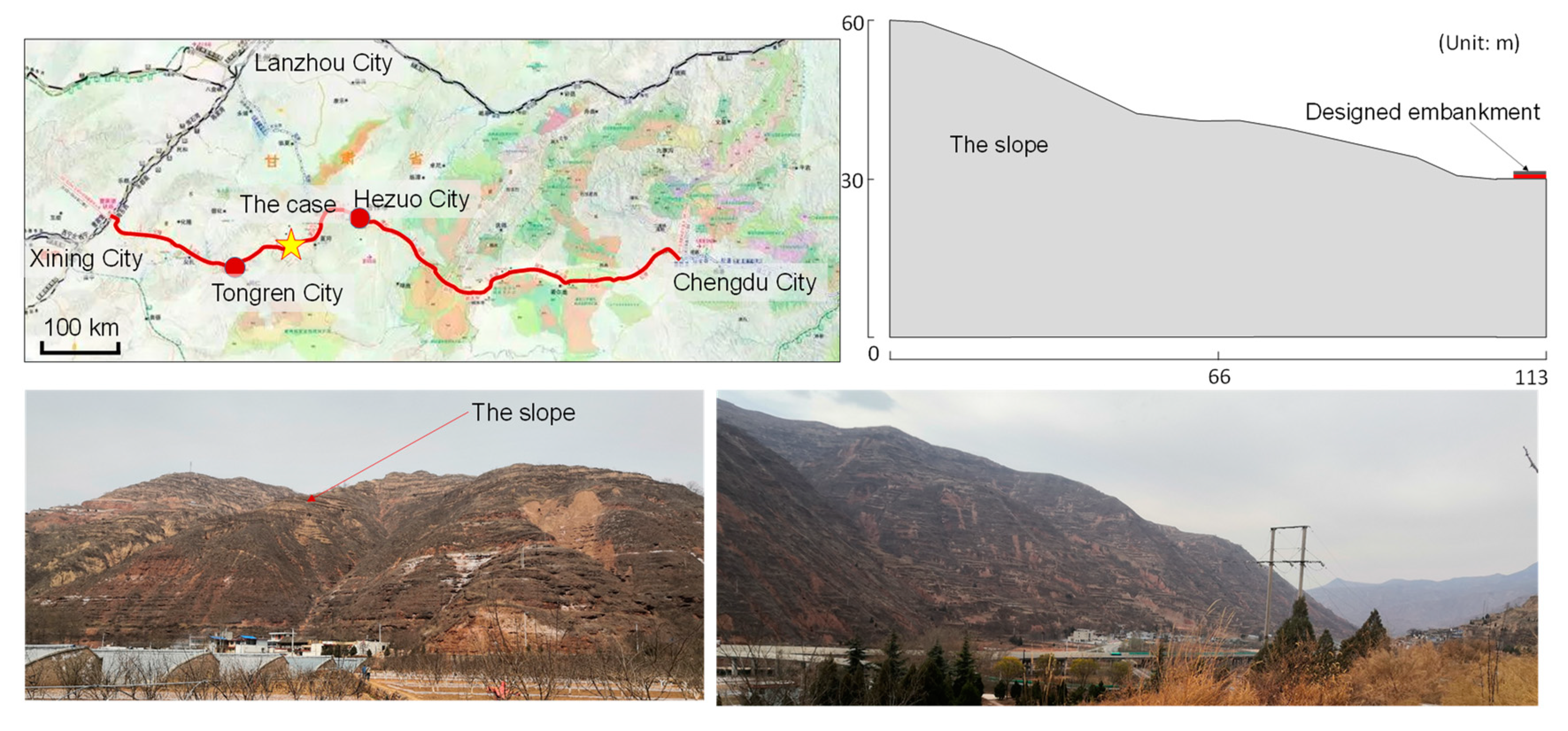


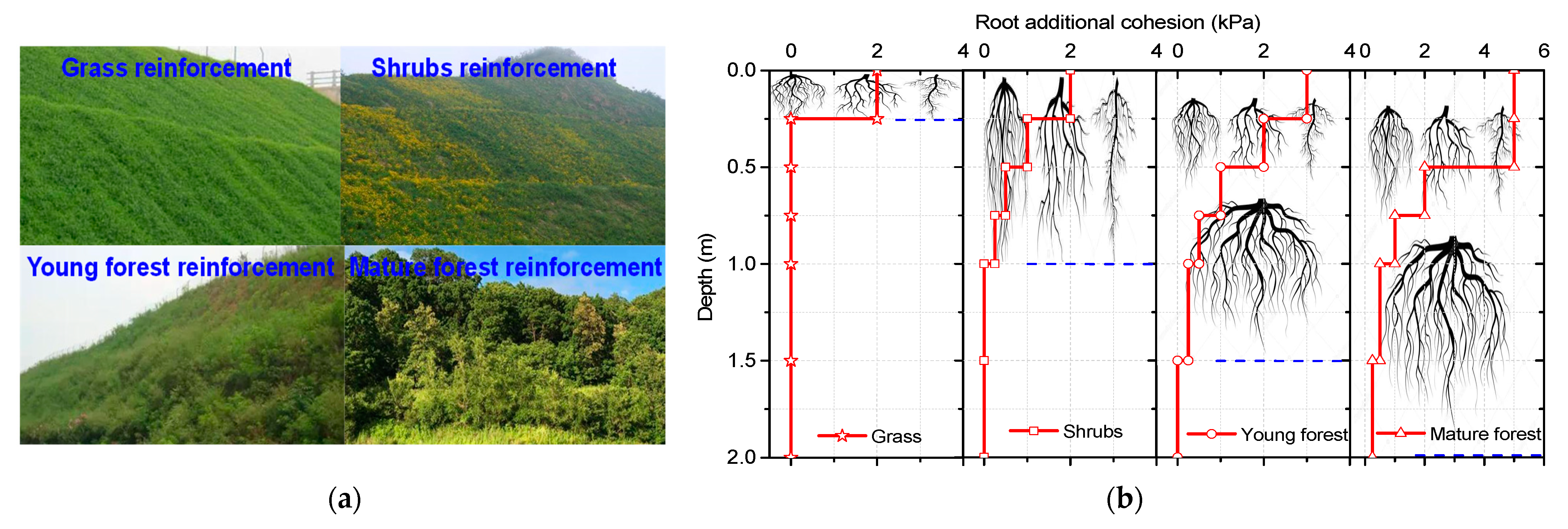
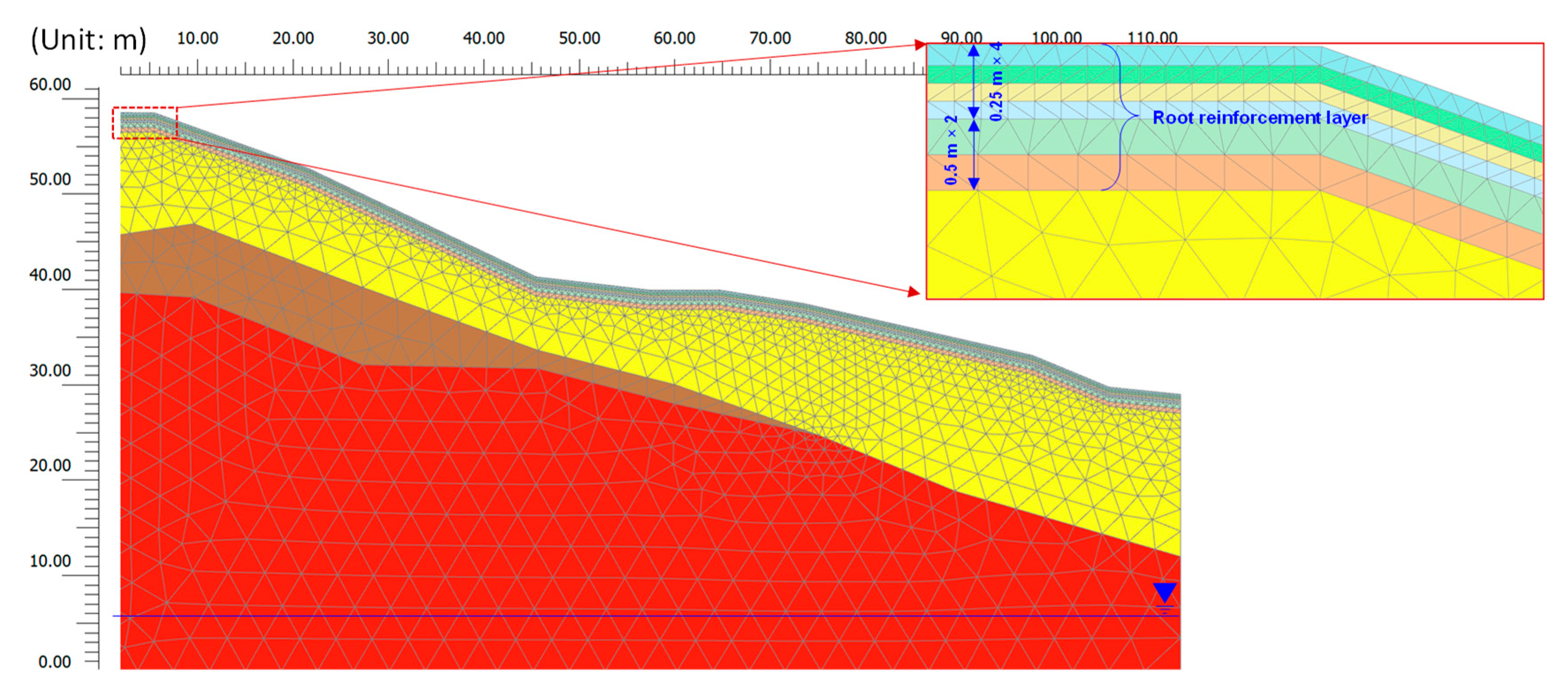
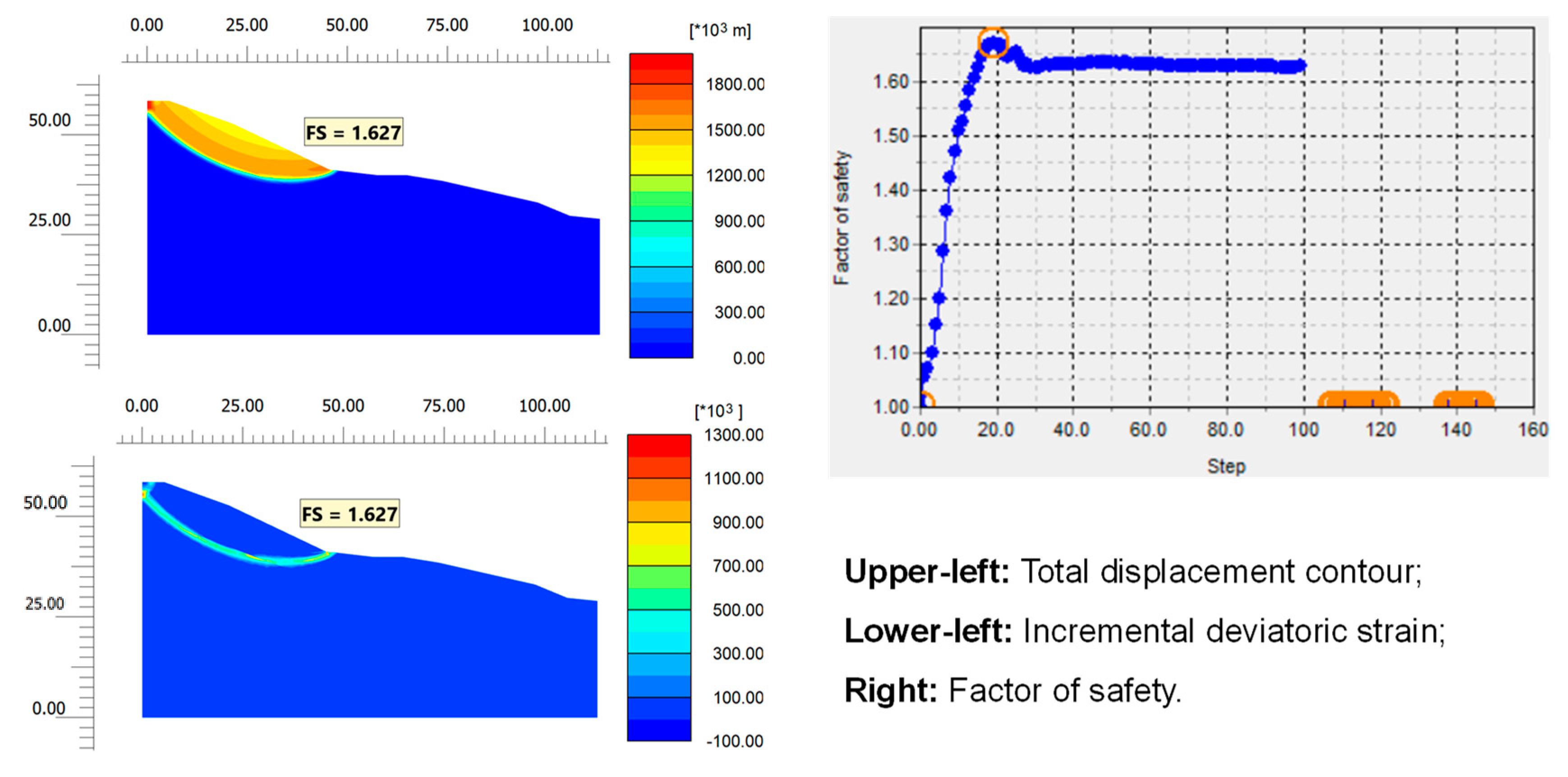
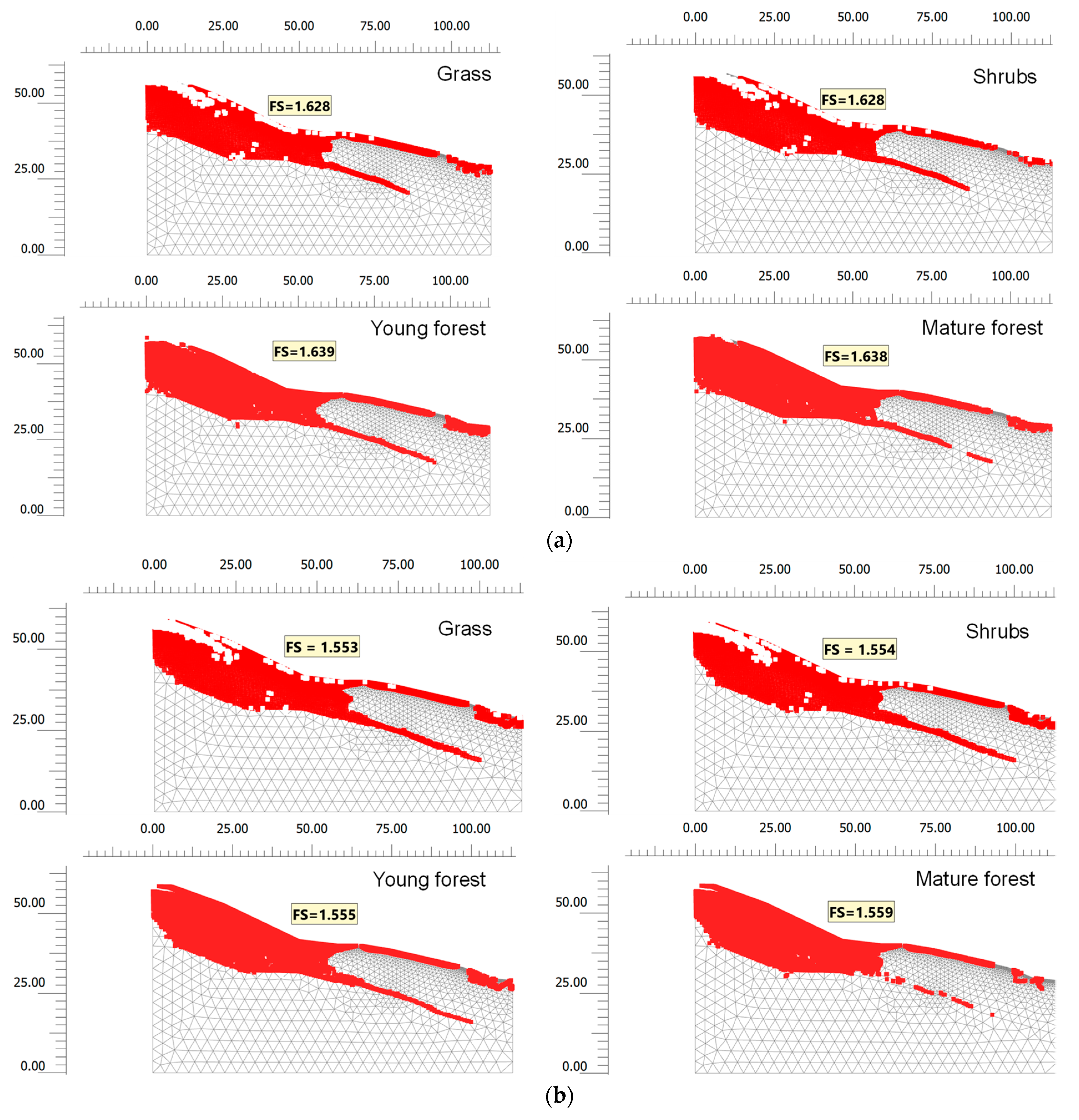

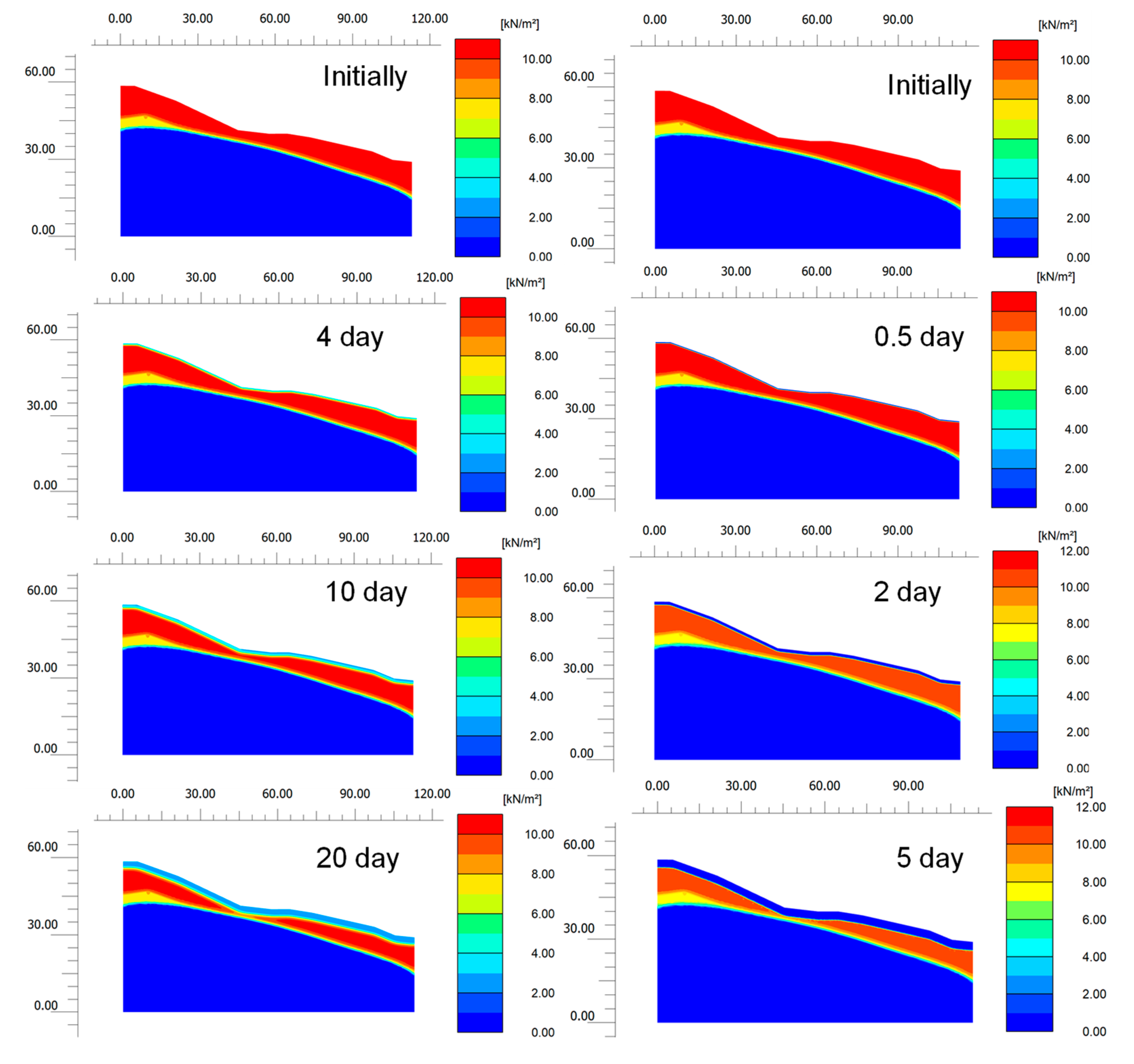
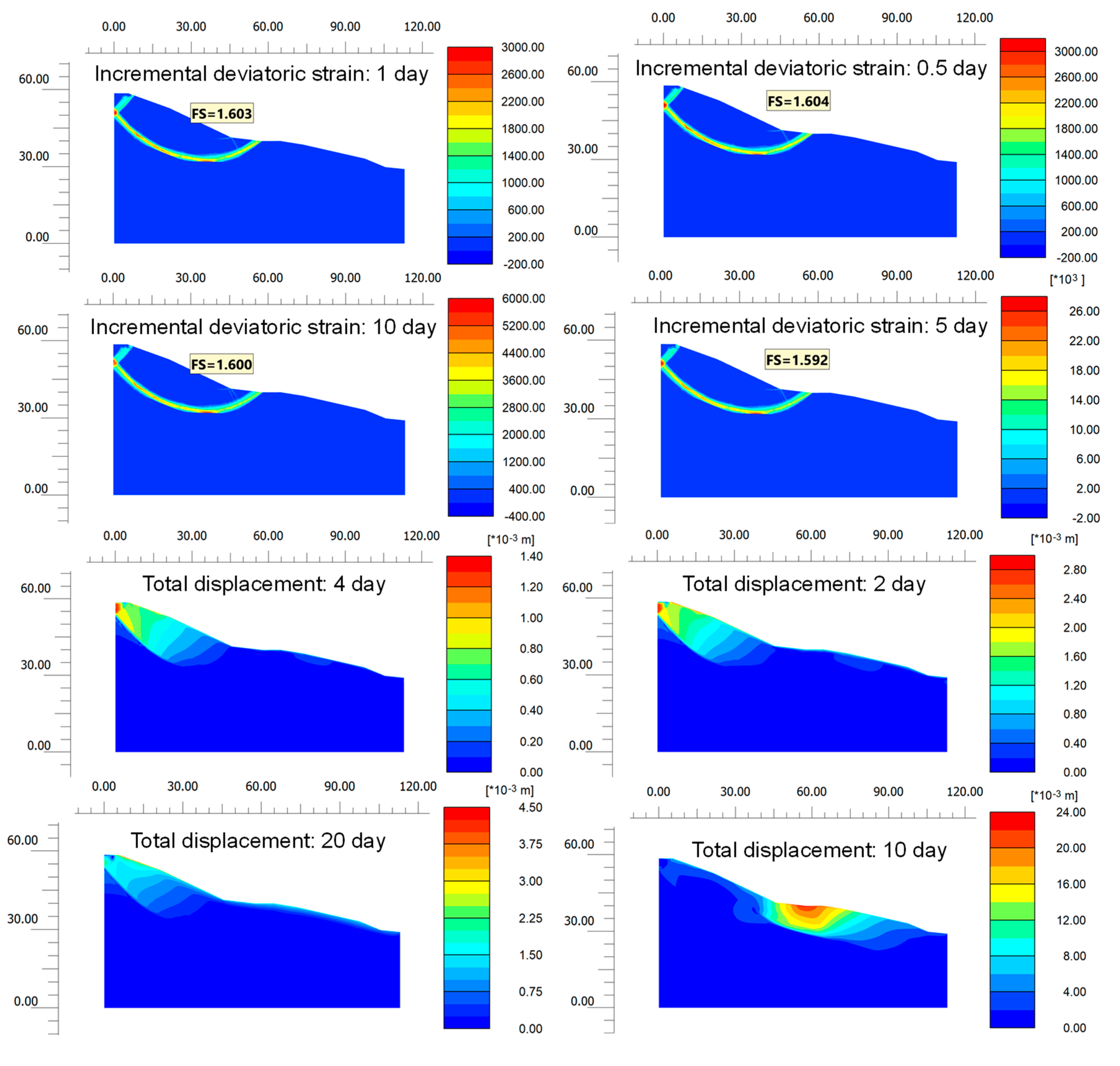
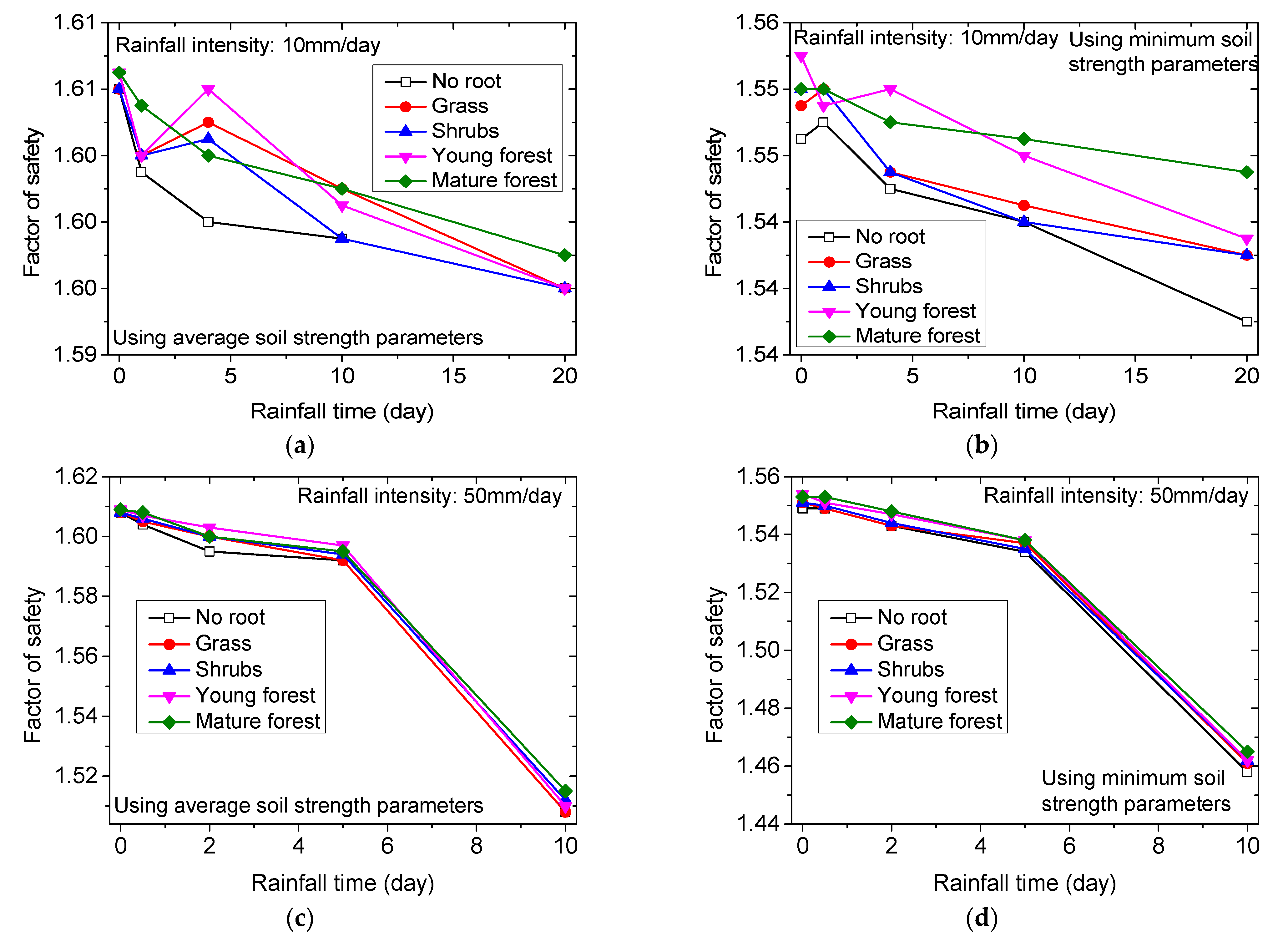
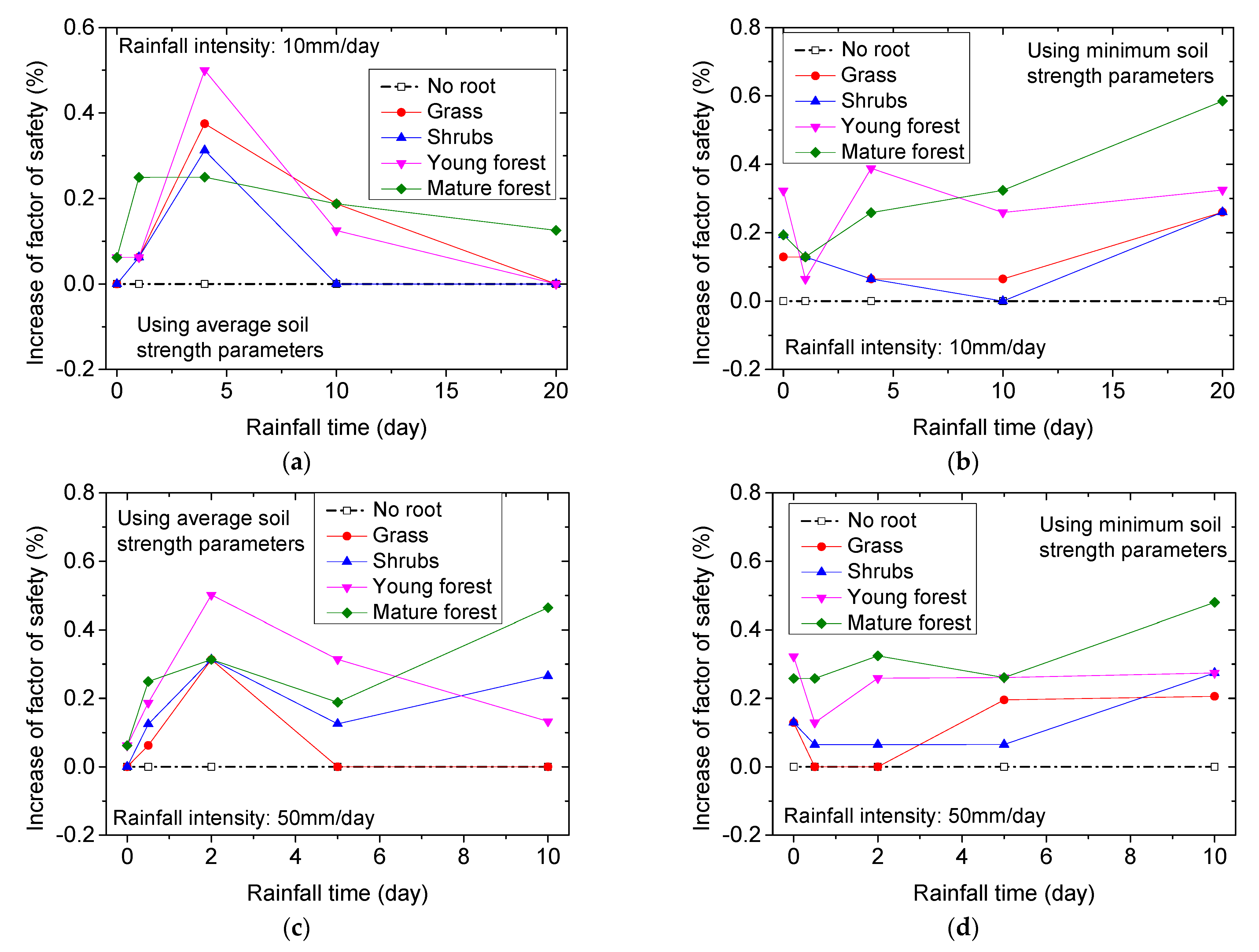
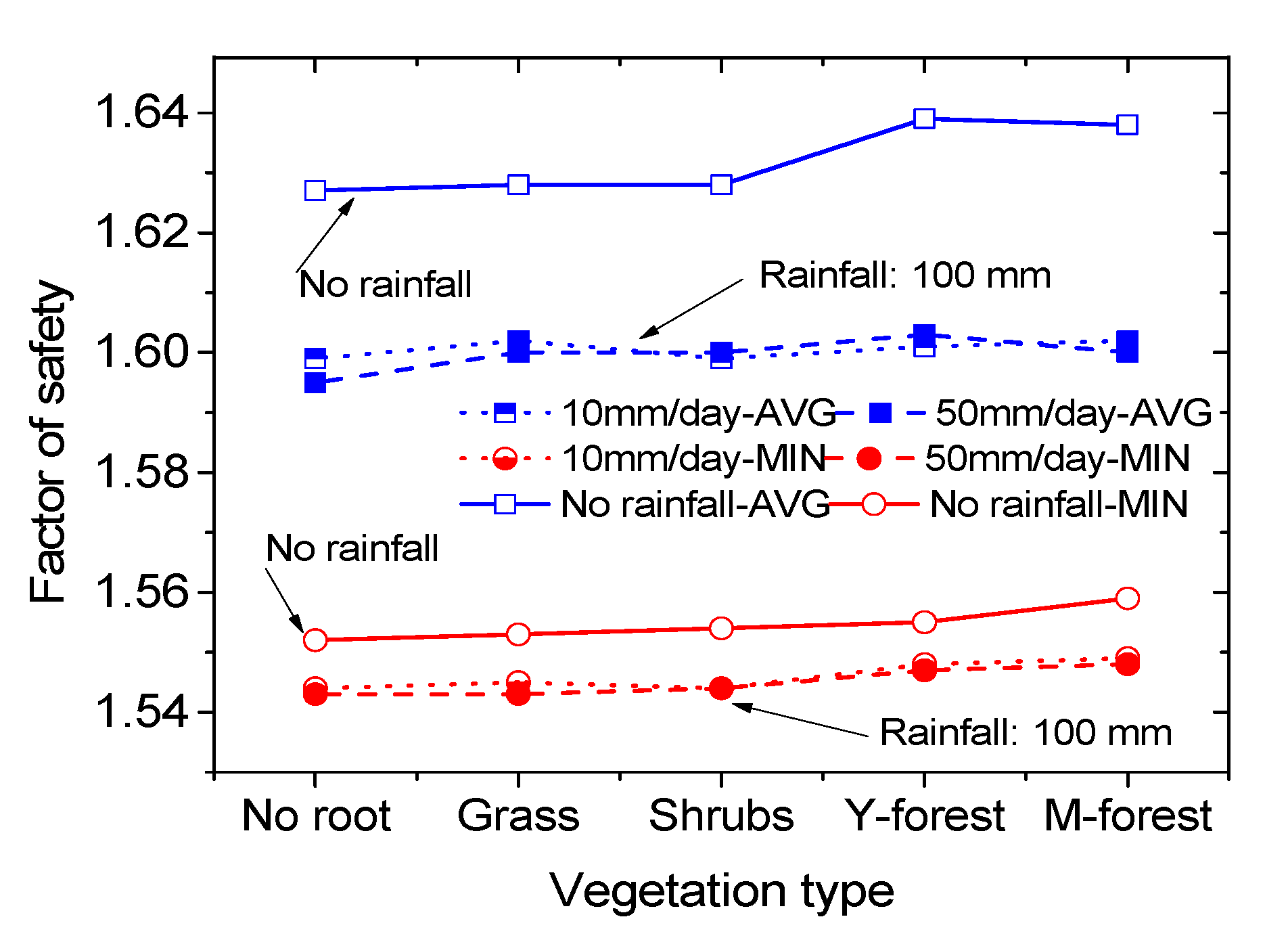


| Soil Properties | Unit | Sandy Loess | Silt | ||||
|---|---|---|---|---|---|---|---|
| Max | Min | Avg | Max | Min | Avg | ||
| Natura moisture content | % | 16.900 | 4.200 | 10.068 | 22.900 | 18.000 | 20.600 |
| Natural density | g/cm3 | 1.840 | 1.430 | 1.570 | 1.890 | 1.720 | 1.820 |
| Dry density | g/cm3 | 1.590 | 1.320 | 1.430 | 1.560 | 1.400 | 1.510 |
| Void ratio | % | 1.049 | 0.694 | 0.892 | 0.929 | 0.729 | 0.791 |
| Water saturation | % | 63.800 | 13.500 | 29.879 | 78.700 | 63.900 | 70.480 |
| Liquid limit | % | 26.500 | 24.900 | 25.497 | 26.100 | 25.400 | 25.700 |
| Plastic limit | % | 17.300 | 16.200 | 16.641 | 16.700 | 16.500 | 16.620 |
| Plastic index | - | 9.500 | 8.400 | 8.856 | 9.400 | 8.800 | 9.080 |
| Liquid index | - | 0.010 | −1.450 | −0.744 | 0.690 | 0.160 | 0.438 |
| Cohesion | kPa | 17.2 | 16.3 | 16.8 | 18.2 | 17.8 | 18.1 |
| Friction angle | degree | 21.6 | 19.4 | 20.7 | 20.6 | 18.8 | 19.4 |
| Soil Layer | Dry Density | Young’s Modulus | Poisson Ratio | Shear Modulus | Cohesion | Friction Angle | ||
|---|---|---|---|---|---|---|---|---|
| Unit | kg/m3 | kPa | / | kPa | kPa | degree | ||
| Sandy loess | 1430 | 11,500 | 0.3 | 4423 | 16.8 a | 16.3 b | 20.7 a | 19.4 b |
| Silt | 1510 | 10,800 | 0.35 | 4000 | 18.1 a | 17.8 b | 19.4 a | 18.8 b |
| Mudstone | 2250 | 411,030 | 0.23 | 167,085 | 112.6 | 34.3 | ||
| Soil Layers | Saturated Moisture Content | α | l | n |
|---|---|---|---|---|
| Unit | % | m−1 | / | / |
| Sandy loess | 47% | 1.360 | −0.8030 | 1.342 |
| Silt | 46% | 0.94 | −1.382 | 1.400 |
| Mudstone | 55% | 2.24 | −0.300 | 2.286 |
Publisher’s Note: MDPI stays neutral with regard to jurisdictional claims in published maps and institutional affiliations. |
© 2021 by the authors. Licensee MDPI, Basel, Switzerland. This article is an open access article distributed under the terms and conditions of the Creative Commons Attribution (CC BY) license (https://creativecommons.org/licenses/by/4.0/).
Share and Cite
Liu, C.; Bi, H.; Wang, D.; Li, X. Stability Reinforcement of Slopes Using Vegetation Considering the Existence of Soft Rock. Appl. Sci. 2021, 11, 9228. https://doi.org/10.3390/app11199228
Liu C, Bi H, Wang D, Li X. Stability Reinforcement of Slopes Using Vegetation Considering the Existence of Soft Rock. Applied Sciences. 2021; 11(19):9228. https://doi.org/10.3390/app11199228
Chicago/Turabian StyleLiu, Chungang, Huanjun Bi, Dong Wang, and Xiaoning Li. 2021. "Stability Reinforcement of Slopes Using Vegetation Considering the Existence of Soft Rock" Applied Sciences 11, no. 19: 9228. https://doi.org/10.3390/app11199228
APA StyleLiu, C., Bi, H., Wang, D., & Li, X. (2021). Stability Reinforcement of Slopes Using Vegetation Considering the Existence of Soft Rock. Applied Sciences, 11(19), 9228. https://doi.org/10.3390/app11199228






